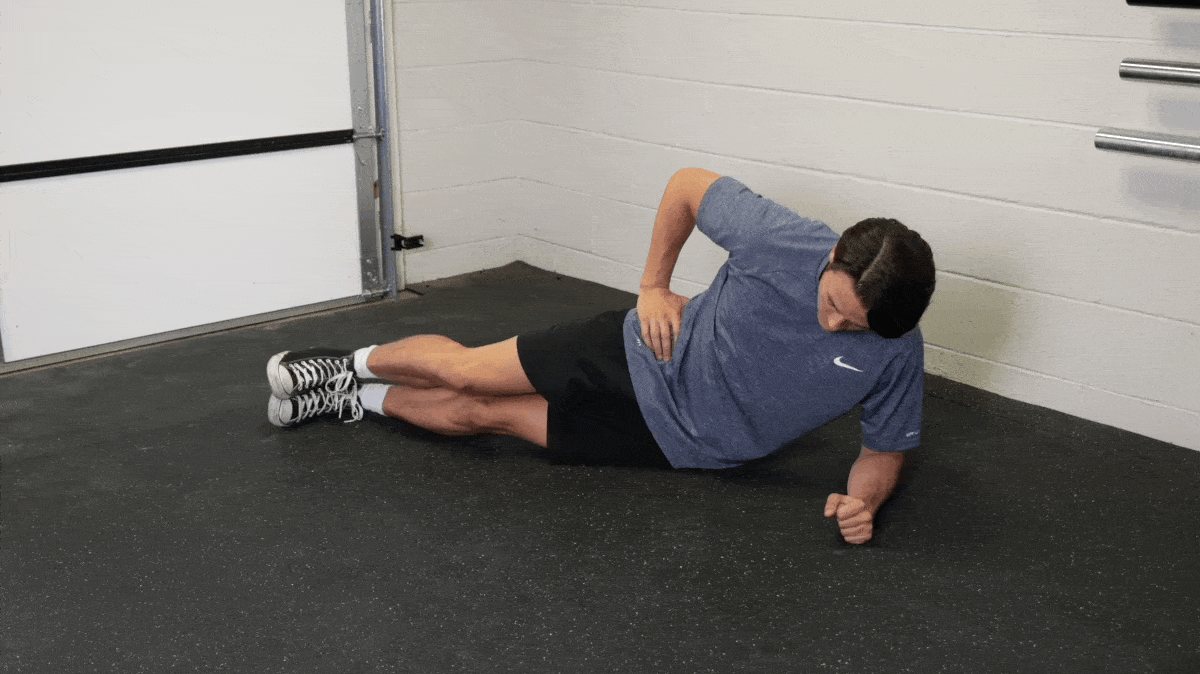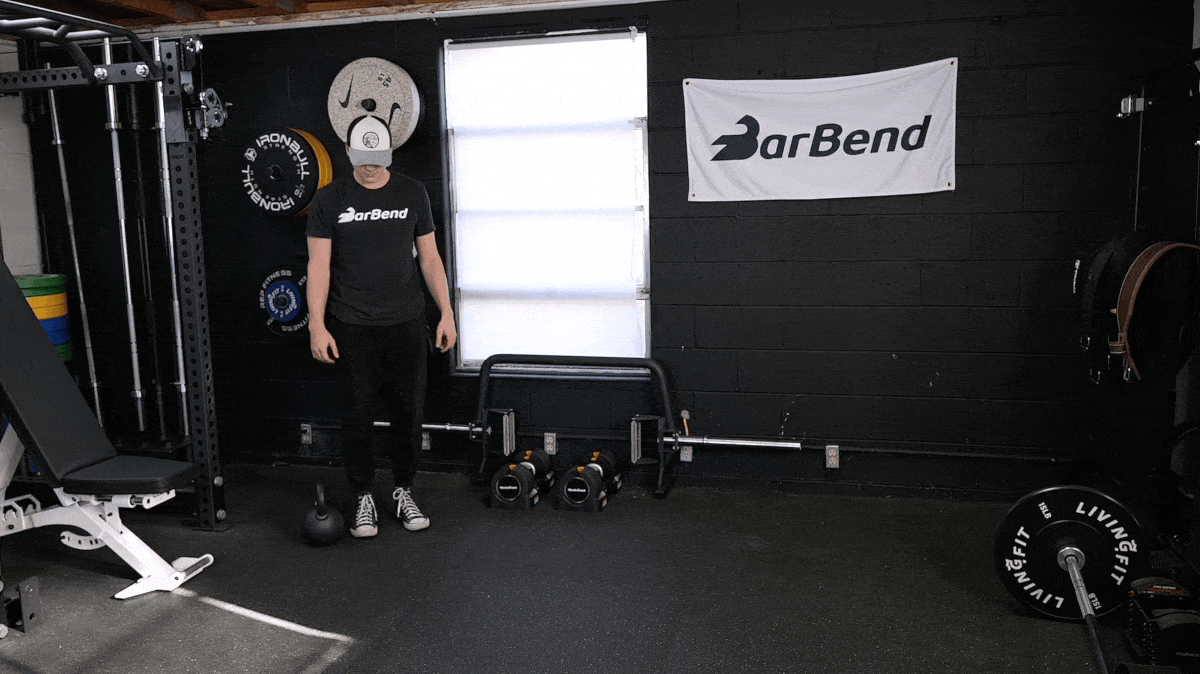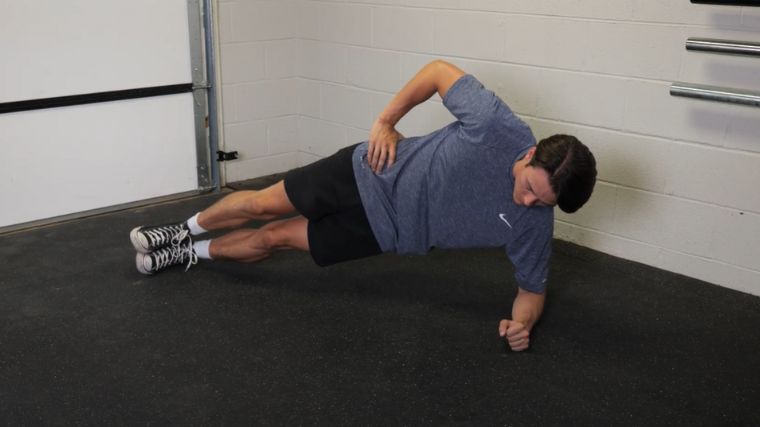Figuring out how to train your abs can be a toughie. It can be tricky to train all of your abdominal muscles in one workout in a way that’s efficient. That’s where the side plank comes in. Much like the traditional plank, the side plank helps teach you how to hold your core under tension isometrically. This isometric training exercise is a key component in maintaining good form and posture under heavy loads. By working one side at a time, the side plank helps you ensure that your core will be strong from multiple angles. Here’s how to do the side plank exercise.
Editor’s Note: The content on BarBend is meant to be informative in nature, but it should not be taken as medical advice. When starting a new training regimen and/or diet, it is always a good idea to consult with a trusted medical professional. We are not a medical resource. The opinions and articles on this site are not intended for use as diagnosis, prevention, and/or treatment of health problems. They are not substitutes for consulting a qualified medical professional.
How To Do the Side Plank

Form-wise, it’s easy to do the side plank — but it’s also easy to do the side plank wrong. Learn how to do it the right way to give yourself maximum benefits. If the stiff-legged side plank is too challenging, you can modify the exercise by bending your knees and resting your bottom knee on the ground as well.
Equipment Needed: To do the side plank, you won’t need anything other than your own body. A yoga mat can make the exercise more comfortable on the parts of your body that remain in contact with the ground.
- Step 1 — Lie on one side with your elbow under your shoulder and your top leg stacked over your bottom leg. You can keep your knees bent or opt to keep your legs straight.
- Step 2 — Press your elbow, your hips, and your bottom foot into the ground. Raise your hips as high as you can, aiming to establish a straight line from your ribs through your hips and bottom leg.
- Step 3 — Once you’ve found your optimal position, hold it as steadily as you’re able. Your top arm can rest on your hip or side with your arm straight or bent.
Coach’s Tip: Start your set on your weaker side. That way, your second set (on the opposite side) can more easily match the time you achieve with your first set.
Side Plank Variations
The side plank is itself a variation of the regular plank. What variations does this variation have lurking? Here are a few of the best ones.
Side Plank With Row
[Read More: 15 Best Plank Variations to Strengthen Your Core and Help You Support Your Big Lifts]
Why Do It: Adding a resistance band can make even the toughest exercises even tougher. And adding movement to an isometric exercise is an almost guaranteed way to increase the challenge even more.
Equipment Needed: You’ll need a resistance band fixed around a stable surface for this side plank variation. You can also use an adjustable cable station.
- Set up for a side plank while facing a resistance band or cable handle.
- Once you’re in the plank, roll over and grab the band or handle, then pull it taut while returning to your plank position.
- From here, brace your core extra hard and row towards your body, keeping your upper arm tucked snugly against your torso.
Rotational Side Plank
[Read More: How to Do the Bear Plank — Proper Form, Benefits, Variations, and More]
Why Do It: Adding a rotation to your side plank is a great way to challenge your balance and make sure that your obliques really are doing what they’re supposed to.
Equipment Needed: You can perform the rotational side plank with or without a free weight in your hand.
- Begin in a side plank position. This variation is easier to do if you stagger your feet rather than place them atop one another.
- Deliberately rotate your top hip around toward the floor, pause for a moment, then twist back to the starting position.
Side Plank Crunch
Why Do It: Performing a crunch at the top of your side plank will require you to bring your top elbow toward your top knee. In doing so, you’ll add lateral flexion to this isometric move. Plus, it’ll increase the balance challenge in a big way.
Equipment Needed: No additional equipment is needed for this one.
- Get into a standard side plank.
- Reach your top arm up out past your head.
- Hold the plank position while “crunching” your elbow to your knee by bringing your top knee up towards your hip.
Side Plank Alternatives
Can’t or don’t want to get on the ground? You don’t have to. These side plank alternatives are best-served standing. Or hanging from a pull-up bar.
Suitcase Carry

[Read More: How to Do the Plank Jack for Killer Abs and Better Conditioning]
Why Do It: The suitcase carry looks nothing like the side plank, but they’ve actually got a lot in common. They’ll both be testing your oblique strength while challenging you to keep your shoulders in a stable position. With the suitcase carry, you’ll be operating under a lot of load offset to one side. This will improve grip strength and even cardiovascular endurance in addition to giving your core a great workout.
Equipment Needed: You can do suitcase carries with any sort of free weight (or even an actual suitcase). Your best bet is to start with a dumbbell or kettlebell.
- Stand next to a weight on the ground.
- Hinge down and grab the weight with the corresponding arm, then stand up with it.
- Stabilize and align your torso, making sure your ribs are stacked above your pelvis and you aren’t tilting your shoulder toward the weight.
- Brace your core and take controlled steps forward while carrying the weight.
Pallof Press

[Read More: Pallof Press vs. Plank — Similarities, Differences, and More]
Why Do It: The Pallof press is another alternative to the side plank that will tax your obliques and overall bodily stability all at once.
Equipment Needed: You’ll be using a cable machine or resistance band to assist you here.
- Tie a resistance band around a stable fixture at around shoulder height, or set an adjustable cable to the same level.
- Take a full step out to the side to pull the resistance taut. Hold the end with both hands in front of you, arms straight.
- Allow the resistance to twist your torso to one side, then reverse the motion by contracting your obliques. Keep your arms locked the whole time.
Who Should Do Side Planks
It might be tempting to skimp on core-specific exercises during your program. Especially if you work a lot of loaded carries and front squats into your training rotation, it’s easy to assume you don’t need any accessory core training. But a little bit can go a long way.
Beginners
Beginners to the gym are unlikely to be lifting enough weight to give their core a full training stimulus without training their abs directly. Especially with modifications like keeping your top foot out on the ground in front of your bottom foot — or even keeping your bottom knee on the ground entirely — the side plank can be accessible to many beginners.
Competitive Strength Athletes
From powerlifters and weightlifters to CrossFit athletes and bodybuilders, a strong core is absolutely essential for strength athletes looking to compete at high levels.
[Read More: 7 Friendly And Oblique Beginner Core Exercise ]
While the side plank might not be the most accessible move for powerlifters and strongman athletes in very heavy weight classes, many competitive strength athletes can benefit from the low-impact isometric stimulus that side planks provide.
If You Work Out at Home
No weights, no problem. The side plank is a spectacular exercise to do when you’re working out without equipment, whether you’re at home or traveling. You can bust out this move wherever and whenever you’re working out — just grab some padding for your elbow and forearm and your ab workout is ready to go.
Side Plank Sets and Reps
Sets and reps look a little bit different for isometric exercises than they do for more dynamic movements. Instead of counting reps, you’ll be counting seconds.
- For Muscle Mass: Do three to four sets per side for 45 to 60 seconds.
- For Strength: Perform two to three sets per side for 30 to 45 seconds. Hold a dumbbell in your top hand during your set to increase your strength.
- For Endurance: Aim to do three sets per side, holding each set as long as possible.
You can customize the number of seconds per set according to your own experience level. So if 45 to 60 seconds feels extremely short, feel free to add weight or extend the duration of your sets.
On the other hand, if 30 to 45 seconds feels extremely long, start smaller. Even five to 10 seconds per side can start helping you build the strength you need to get your core stronger.
Benefits of the Side Plank
If you want to maximize your core strength and your performance in the gym overall, you don’t want to sleep on the side plank. Here’s why.
Improve Squat and Deadlift Strength
The squat and deadlift have you moving straight up and down. Ideally, you don’t have any side-to-side movement in there. Strengthening your obliques is actually a huge part of this. The stronger your core is overall — including your obliques — the more stable your up-and-down barbell lifts can be.
[Read More: Challenge Your Core With the Reverse Plank]
With a stronger, more stable core — which the side plank will help you build — you’ll be better able to transfer force as efficiently as possible into moving a loaded barbell. This translates into stronger, more powerful lifts.
Practice Bracing and Breathing
If you do nothing else during your side plank, you still need to breathe. Filling up your core with air from 360 degrees while it’s under isometric tension is excellent practice for heavy bracing under big loads. When you’re piling on the weight plates, you’ll be grateful for the practice of taking deep belly breaths under tension.
Build a Stronger Core
Perhaps the most obvious benefit of side planks is forging a stronger core. By integrating side planks into your program, you’re prioritizing a strong, stable core that can support you through any kind of loaded movement — from fast-paced, explosive exercises to slow, grinding deadlifts.
Prevent Back Pain
No gym exercise is a replacement for legitimate medical care. That said, under guidance from a qualified professional, training muscles like your obliques with moves like the side plank is a wise choice if you suffer from back pain. Studies repeatedly show that core exercises improve pain outcomes as long as you’re diligent and maintain good form. (1)
Muscles Worked by the Side Plank
This one’s pretty straightforward. The side plank primarily works the sides of your core — your obliques. You’ll be involving your hips and shoulders, too, since those will be holding you up. But mostly, all the pressure to perform this isometric move should be squarely on your obliques.
Obliques
Your oblique muscles make up the sides of your core. You’ve got internal and external obliques, both of which cross your torso diagonally. Your external obliques kick in with hip flexion (bringing your knees toward your chest) and help rotate your spine.
[Read More: The Best Core Exercises for Strength at Any Fitness Level]
The internal obliques are also big players in your side plank. It’s a good thing, too, because these puppies support your abdominal wall, helping to keep your spine stable. This is especially handy when you’re bracing for and performing forced respiration during your heavy loaded lifts — think deadlifts and squats.
Abdominals
Any exercise that involves preventing movement in your torso will engage your abs, or rectus abdominis, to some degree. Your “six-pack muscle” doesn’t do a whole lot here, but you can definitely consider the side plank a general ab exercise to some degree.
Common Side Plank Mistakes
It’s easy to hop onto your side, lift your hips for a few mindless seconds, and call it an ab workout. But to maximize your core gains, you’ll want to make sure you’re doing it properly. Here are a few typical mistakes in the side plank that you’ll want to avoid.
Holding Your Breath
One of the biggest crimes you can commit during your side plank is forgetting to breathe. When you’re not breathing, you’re failing to bring this lift to its fullest potential. Hold your core in a strong brace during this lift, and take big, slow breaths through your abdomen. Really fill your belly up with each slow breath.

[Read More: The Right Way to Breathe When You’re Doing a Plank]
This will increase your muscular engagement and force your core to work a whole lot harder. Breathing during your side planks will also give you excellent practice at controlled breathing during a strong core brace. That will come in handy during lifts as versatile as deadlifts and overhead presses.
Sinking Your Hips
Even though this is a core exercise, the movement is all about your hips. Keeping your hips up — as though there’s an invisible string pulling them up toward the ceiling — is critical for an effective side plank. When your hips start to sink, your core muscles become much less involved in the movement.
Maintaining maximum core involvement means a focus on keeping your hips up and steady. Doing so will ensure that your obliques are as involved as they can be.
Not Holding Long Enough
Side planks can be intimidating for even the strongest of athletes. If you’re used to hoisting heavy barbells, manipulating and holding your own body weight might not be in your normal wheelhouse.
To avoid the discomfort that can come with exercises like this, many lifters may end their sets too early. Make sure you’re focusing on what your core can handle, letting your body approach failure before your mind. You can do this little by little, pushing one or two seconds longer than you think you can with each passing set.
Shrugging Your Shoulder
You don’t want to be focused on your arms during this isometric hold. Instead, you want all the emphasis to be on your core and your hips. To facilitate this, make sure you’re keeping your shoulder down and away from your ear. Continue to avoid shrugging your shoulder up toward your face even when the going gets tough.
If you don’t feel like there’s an alternative, it might well be time to call it a set and go again after a period of rest. To further increase your arm’s comfort — which might be a reason your shoulder starts to shrug — place a soft yoga mat or exercise mat under your elbow and forearm.
FAQs
You’ll find the side plank pretty much everywhere you find ab training. So it’s understandable to have a lot of questions about it. Here is a load of answers.
You should hold the side plank for as long as you can hold excellent form (and keep your time even on both sides). For some athletes, this may last five to 15 seconds. In that case, add to that time gradually, pushing your efforts further a few seconds at a time until you can approach a 30-second or even 45-second plank on either side.
Other athletes may be able to hold the side plank much longer, and that’s great, too. If you can, aim to hold the side plank for 30 to 60 seconds per side. If you can go even longer than that, try to make it to 90 seconds.
Once you can comfortably hit the 60 to 90-second range with good form, consider upping the ante with variations like the side plank crunch and side plank rotations.
The side plank is one of the best bodyweight exercises that will challenge your obliques, for sure. As long as you keep your hips pressed up so that your lower body forms a straight line from your shoulders down to your heels, your obliques will likely feel the tension. They’ll get a lot stronger as a result.
You can make the side plank more accessible by placing your top foot on the ground in front of your bottom foot. This will widen your base of support and give you a stronger starting point, making balance less of an issue. You can also lower your bottom knee completely, letting it rest on the ground to give yourself more points of contact.
If you want to modify the side plank to make it even more challenging, add a rotation to the mix while holding a dumbbell. You can also add a crunch or resistance band row your side plank to give yourself an added stability and balance challenge.
References
- Chang WD, Lin HY, Lai PT. Core strength training for patients with chronic low back pain. J Phys Ther Sci. 2015 Mar;27(3):619-22. doi: 10.1589/jpts.27.619. Epub 2015 Mar 31. PMID: 25931693; PMCID: PMC4395677.
Featured Image: Reshetnikov_art / Shutterstock